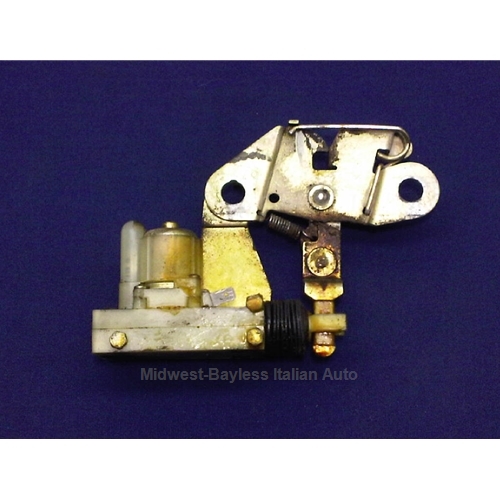ng_randolph
Bjorn H
Shortly after I got my X1/9 I added power door locks and keyless entry. At the time I also put in wiring for remote trunk release for a potential future upgrade. Well, the future is now; I completed the trunk release install in August.
Several people here have added remote trunk release, and one of the difficulties encountered is the force required to open the latch. There is a fairly strong coil spring external to the latch, presumably there to make sure the lever in the door jamb retracts properly. @drsnemann measured the force needed to be 15.4 lbf, or just under 70N. People have dealt with this in different ways; Removing the external spring (@lookforjoe), using a stronger actuator, or adding leverage . I chose the latter.
To get an idea of what is required, I put a camera in the trunk and recorded while opening the trunk. The minimum movement needed at the butt end of the lever is just about 5 mm. I wanted to use a MES door lock actuator, as I have found these to be very reliable. I measured the actuator travel to be 23 mm, and the vendor claims it to be "capable of dead lifting over 8 pounds!), or about 35N. So I set out to increase the leverage about 3x, reducing the required force to around 23 N and giving just over of 7 mm of travel. There is a bit of wiggle room on the travel; when attaching the manual trunk release cable one can (should) put in a bit of preload. This reduces the travel needed, and helps the door jamb lever retract.
The trunk latch is riveted together, and I ground off the rivet heads to open the unit. I made a CAD-drawing of the existing latch lever, then extended it about 50 mm. SendCutSend (my new best friend) laser cut one from 1/8" 304 stainless steel for not much money.

Rather than riveting the latch back together, I drilled up the rivet holes in the rear facing half and installed press-in spacers.


On the forward facing half I drilled up the holes and installed M3.5 PEM-nuts (M3.5 to fit the 3.6 mm ID of the spacers)


After a thorough cleaning I greased up the moving parts and assembled the latch with truss head screws and thread locker. SendCutSend does not do coining, so I used an M2.5 pan head screw for the end stop. 3M DP420 epoxy in lieu of thread locker on this. As it happens, the actuator limits the travel and I don't actually hit this stop screw.


Several people here have added remote trunk release, and one of the difficulties encountered is the force required to open the latch. There is a fairly strong coil spring external to the latch, presumably there to make sure the lever in the door jamb retracts properly. @drsnemann measured the force needed to be 15.4 lbf, or just under 70N. People have dealt with this in different ways; Removing the external spring (@lookforjoe), using a stronger actuator, or adding leverage . I chose the latter.
To get an idea of what is required, I put a camera in the trunk and recorded while opening the trunk. The minimum movement needed at the butt end of the lever is just about 5 mm. I wanted to use a MES door lock actuator, as I have found these to be very reliable. I measured the actuator travel to be 23 mm, and the vendor claims it to be "capable of dead lifting over 8 pounds!), or about 35N. So I set out to increase the leverage about 3x, reducing the required force to around 23 N and giving just over of 7 mm of travel. There is a bit of wiggle room on the travel; when attaching the manual trunk release cable one can (should) put in a bit of preload. This reduces the travel needed, and helps the door jamb lever retract.
The trunk latch is riveted together, and I ground off the rivet heads to open the unit. I made a CAD-drawing of the existing latch lever, then extended it about 50 mm. SendCutSend (my new best friend) laser cut one from 1/8" 304 stainless steel for not much money.
Rather than riveting the latch back together, I drilled up the rivet holes in the rear facing half and installed press-in spacers.
On the forward facing half I drilled up the holes and installed M3.5 PEM-nuts (M3.5 to fit the 3.6 mm ID of the spacers)
After a thorough cleaning I greased up the moving parts and assembled the latch with truss head screws and thread locker. SendCutSend does not do coining, so I used an M2.5 pan head screw for the end stop. 3M DP420 epoxy in lieu of thread locker on this. As it happens, the actuator limits the travel and I don't actually hit this stop screw.

